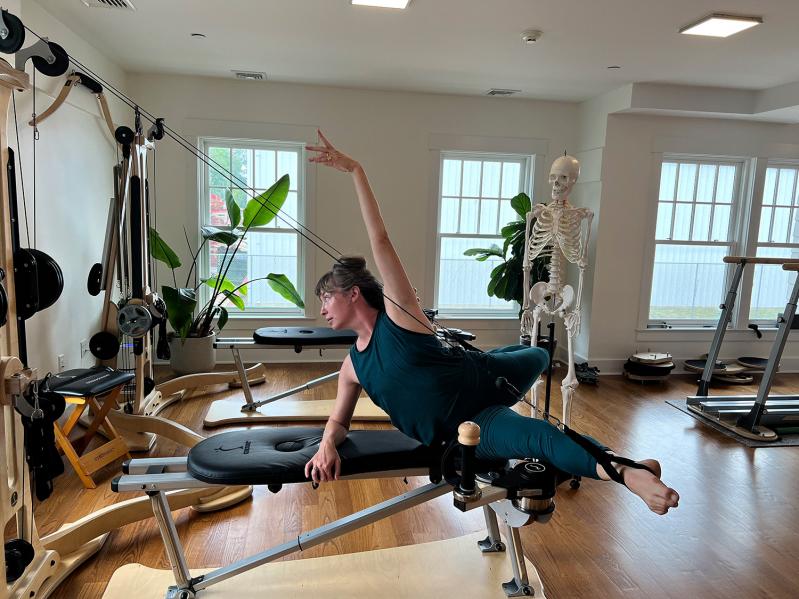A not entirely fictionalized conversation:
"Have you tried Gyrotonics?"
"Gin and tonic?"
"GYROTONICS. It's taught at the Seed Center in East Hampton."
"The Seed Center?"
"Yes, on Lumber Lane."
"Is it a greenhouse?"
"No."
"Marijuana dispensary?"
"No."
"Fertility clinic?"
"No one really knows what we are," said a smiling Charley Aldred, the owner of the Seed Center studio in East Hampton. There she teaches a form of exercise known as the Gyrotonics Method, which consists of a series of low-impact, meditative movements, performed in circular, spiraling, and undulating patterns, on machines that most closely resemble those used in Pilates.
"All the movements are three-dimensional and circular," she said, as I lay spread-eagled on a machine called the Gyrotoner, stretching and twisting my spine and upper body around and around in giant circles. "Bushy tail out, flatten your armpits, fingernails shooting sparks. Let your spine soften. Turn and make a twist, like a bow and arrow," she instructed.
It felt like a fusion of yoga, dance, tai chi, gymnastics, swimming, and playing on a jungle gym. Ultimately, it was like a much-needed wringing out of a tired body.
"Gyro affects you on all levels -- your respiratory system, your lymphatics, your circulation," she continued. "Unlike yoga, where a teacher may come by and correct your posture, these machines offer constant feedback because they support you and constantly correct your form."
Her large, airy, plant-filled studio on the second floor of a small business complex near the Y.M.C.A. East Hampton RECenter is a maze of machines that look like medieval torture equipment but are, in fact, designed to make you feel as though you're suspended in water. They all have names -- the Jumping Stretching Board, the Archway, and the Gyrotonic Pulley Tower, among others.
They mostly feature beachwood frames and a series of weighted pulleys, rotational discs, and straps that are attached to your feet or looped around your armpits. Their purpose is to help simultaneously stretch and strengthen the body, increase range of motion, correct posture, and develop coordination.
The Gyrotonic Expansion System, as it's also known, was originally created for dancers by Juliu Horvath, a Romanian-born, ethnic Hungarian gymnast and dancer who defected to the United States around 1970. In an attempt to rehabilitate his own injuries, it has been reported, he developed a system of exercises based on the movements of an octopus, a monkey, and a cat -- animals that have the ability to move fluidly and three-dimensionally, but always with strength and control.
Later, as the practice grew in popularity, he redesigned it for non-dancers and athletes.
Ms. Aldred, 42, was a professional ballet dancer for 13 years with the Miami City Ballet and the San Francisco Ballet. When she was 19, she was introduced to Gyrotonics in Miami and has practiced it ever since.
"When you're dancing 12 hours a day, six days a week, it's really hard on your body. Even though I had all the best resources available for recovery, Gyro was what I believe helped me rehabilitate and prevent injuries. I never had any surgeries my whole dance career," she said.
In 2013, she retired because she wanted to become a Gyrotonics teacher, and two years later opened her first studio in San Francisco. Gyrotonics isn't widely known, she believes, partly because it's trademarked and licensed, unlike Pilates. Teacher certification, therefore, is very strict and regulated, available only in three places in the U.S.
By 2020, she was married to Nate Aldred, an East Hampton native, and they had a 3-year-old and a newborn. The Northern California wildfires and Covid restrictions had the young family shut indoors for days, so they decided to move east, settling in Springs, where her children will attend school in the fall and her husband works as an arborist.
She opened the Seed Center in 2021 and now teaches six days a week. Her clients range from ages 9 to 93. The learning curve is steep, she said, because the movement requires bilateral brain coordination. In other words, moving two parts independently. It's not easy.
"It may be a little hippie-dippie for some people, especially type-As who always want to 'feel the burn.' With them, I have to work harder," she said. "But, our bodies are like clay. What we do with them is how we sculpt them. I see young kids all the time who are doubled over because they're always on their phones. And when I worked with San Francisco techies, I saw 30-year-olds who couldn't move their necks."
Barbara Borg, an Amagansett resident, was in the studio the day I arrived. "Bushy tail and stretch your fingers forward," cooed Ms. Aldred, gently guiding her client's back down and forward. "Your body should feel like it has no muscles, no bones."
Ms. Borg has been a Gyrotonics devotee for about seven years, and was delighted when the Seed Center opened because, she said, "It's great for an aging body." She's in good company -- Lady Gaga, Sting, Andy Murray, Liv Tyler, Madonna, and dancers from the Joffrey Ballet and the Alvin Ailey American Dance Theater are known to be practitioners.
The supposed benefits of a regular Gyrotonic practice not only include an increased range of motion, particularly in the spine, but also help with a multitude of lower back or cervical spine pain, such as sciatica, repetitive strain injury, multiple sclerosis, osteoporosis, and rheumatoid arthritis.
Naturally, such goodness comes with a hefty price tag: $195 for a private one-hour session. To help with the cost, Ms. Aldred has introduced two group classes a week, for up to four people.
"I'm trying to do more community outreach," she said. "I'd love to make this more affordable to everyone. Because the health of a community depends on healthy individuals."




